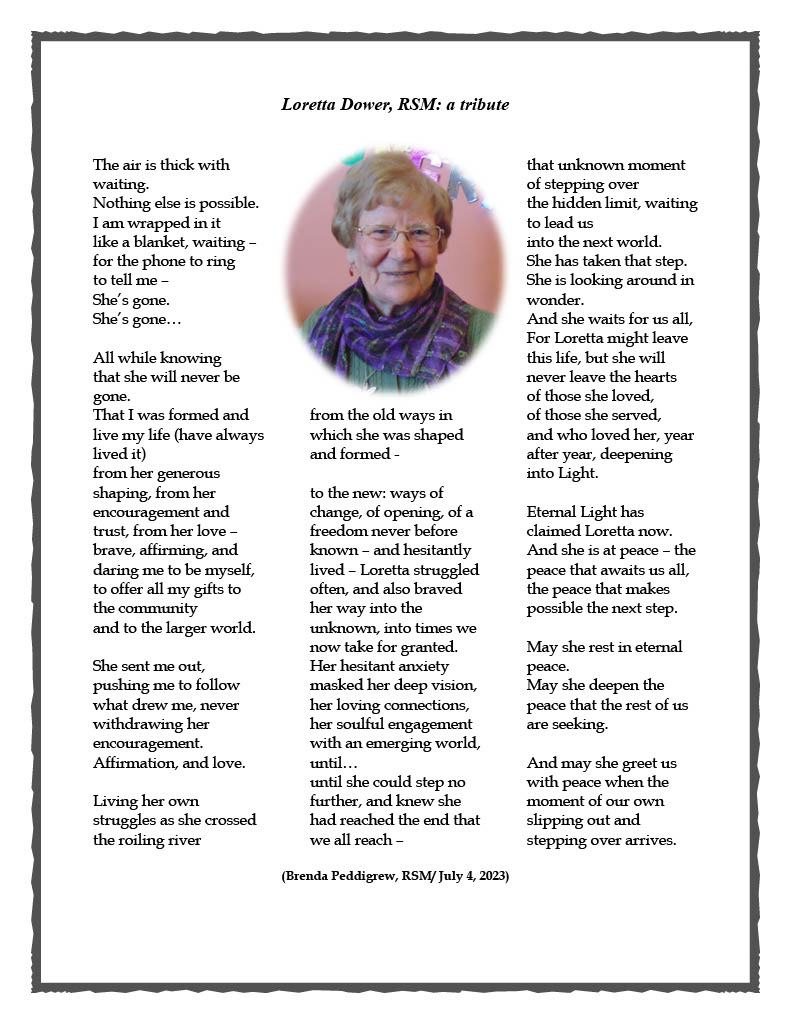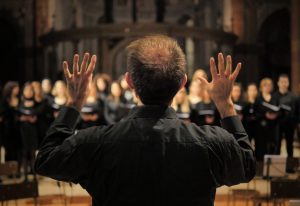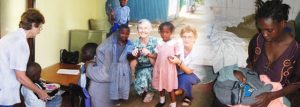On 5 June, Sr Loretta Dower entered into eternal life. This tribute was written by Sr Brenda Peddigrew.
Category: Congregation
Kiwanis Music Festival
The Kiwanis Music Festival is an annual event that began with a two-day event in 1952 with 193 entries and two adjudicators; in 2010 it spans 12 days, with well over 6,000 participants and nine adjudicators. It is the largest festival in eastern Canada.

Musicians young and old have come to appreciate the “Festival” and enjoy this competitive opportunity to showcase their musical talent and their love and commitment to voice, instrumental and choral music. Every performer or group has the opportunity hear and learn from the instant evaluation of their performance by the expert and professional adjudicators. The adjudicators speak to them in order to teach and encourage. Marks are given, even though sometimes an adjudicator admits difficulty in giving marks to one group over the other.
Sisters of Mercy and their students in St. John’s and area schools have been part of the Kiwanis Music Festival since its foundation. Thousands of the sisters’ students – solists, duos and trios and combinations of the same, choirs, choral speech groups, instrumentalists, orchestras and bands from St. John’s, Bell Island, Goulds, Bay Bulls, Brigus, Conception Harbour and from as far as Marystown have entered the festival and have excelled.
Much is owed to the music teachers of our Congregation and of the Presentation Congregation for their commitment to music and culture and for nurturing the innate talent of the youth of our province. They are the true and consistent pioneers of our musical heritage. Some of them have rightly been inducted as members of the Hall of Fame of the Music Festival Association. There are no sisters taking groups to the Festival these days but their many students are doing that now. The baton has been passed and is calling forth the best of music in the next generations!
Ministry to Individuals, Groups, Families
The Family Life Bureau, established in the Archdiocese of St. John’s in 1976, offers counseling in a whole range of areas including individual, marriage, and family counseling. Clients of the staff of the Bureau are either self-referred, referred from the courts, from physicians, various community agencies, and from priests throughout the Archdiocese.
 Discovering and using your strengths to deal with personal and family life issues . . . Support to see you through . . .
Discovering and using your strengths to deal with personal and family life issues . . . Support to see you through . . .
Pastoral counseling is healing the mind, spirit, and relationships through the wisdom of behavioural sciences and spiritual values.
The goal of the Family Life Bureau is to foster positive changes in the lives of persons. Every person has within him/her the energy for growth. Troubled people seek out help when external circumstances lead to distressing separation from others, internal conflicts that cause pain and inner division, and when the life force within them is blocked from healing and growth.
 Sister Loretta Walsh, rsm, Executive Director of the Family Life Bureau, is a facilitator and counselor. She and two other certified counselors provide individual, couple, group and family counseling. They also organize and facilitate workshops and marriage preparation seminars. The workshops deal with issues related to family life, parenting, interpersonal relationships, separation and divorce, personal growth, youth, dealing with drugs, assertiveness and self-esteem.
Sister Loretta Walsh, rsm, Executive Director of the Family Life Bureau, is a facilitator and counselor. She and two other certified counselors provide individual, couple, group and family counseling. They also organize and facilitate workshops and marriage preparation seminars. The workshops deal with issues related to family life, parenting, interpersonal relationships, separation and divorce, personal growth, youth, dealing with drugs, assertiveness and self-esteem.
One interesting program brings married couples together for a candlelight dessert and facilitated conversation about their relationship. This marriage enrichment component is facilitated collaboration with the West End Baptist Church and some Anglican parishes in St. John’s.
Ministry in Africa
In 2007 two Sisters of Mercy from Newfoundland took a bold and courageous step to join Sisters of Mercy from Ireland in their ministries in Africa.

One sister cared for people in Kenya, men, women and children, suffering from HIV and AIDS. She served as a unit coordinator in an AIDS center for the poor. During 2007 a second Sister ministered among others suffering from HIV/AIDS in Zambia. These two Newfoundland sisters were the first to have taken on the adventure and challenge of ministering on the African continent.
Food Programs
Breakfast and lunch programs are a reality in the richer northern hemisphere. Sisters of Mercy support these programs financially and volunteer their time and energy to help feed the poor. We have recently ventured into ministry in Africa. Our sisters have participated with the Irish Sisters of Mercy in providing food to children and families in Kenya and Zambia.
 Food Banks have evolved in our society to serve the needs of the poor and those who find themselves in a financial crisis and lacking food. Many of our sisters throughout the province of Newfoundland and Labrador commit themselves on a regular basis to setting up, managing or volunteering their time in food banks.
Food Banks have evolved in our society to serve the needs of the poor and those who find themselves in a financial crisis and lacking food. Many of our sisters throughout the province of Newfoundland and Labrador commit themselves on a regular basis to setting up, managing or volunteering their time in food banks.
Kitchens have been set up in the many small pueblos where our sisters minister in the Andes of Peru or on the Pacific coast. With grain, oil and flour that is provided by world relief agencies many children are fed a nutritious breakfast or lunch during their school day. Sisters of Mercy help support this program and offer their time working in them. One such centre in Monsefu has been named after one of the early Mercy missionaries, Sister Mary Dorothy Carroll.
Outreach to the Poor
From its foundation the Mercy Congregation has had a special ministry to the poor. Care for the poor and oppressed was especially dear to Catherine McAuley’s heart and the driving force behind her decision to found a religious order. “Service of the poor, the sick and the ignorant” is considered to be a fourth vow of the Sisters of Mercy.
 Immediately on their arrival in St. John’s the three founding members of the Newfoundland mission, Sisters Ursula Frayne, Rose Lynch and Francis Creedon, began the visitation of the poor and the sick in their homes.
Immediately on their arrival in St. John’s the three founding members of the Newfoundland mission, Sisters Ursula Frayne, Rose Lynch and Francis Creedon, began the visitation of the poor and the sick in their homes.
Over the years even though many of the sisters have been fully occupied in their teaching and nursing ministries they found time to visit individuals and families in need. In addition to the more “informal visitation,” ministry to the poor has taken on a more structured format in facilities like the Gathering Place, Food Banks, Prisons, Women’s Centres, Breakfast or Lunch Programs, Family Care Centres.
Whether formally organized or not, care and attentiveness for the poor has been part of our Mercy culture: a poor child in the school, a poor patient in the hospital or nursing home, poor families in the neighbourhood, or a poor person begging food at the door. Love and care for the poor and a congregational option for the poor is the challenge and the blessing of the Gospel and of our Mercy charism.
Desde su fundación, la Congregación de la Misericordia ha tenido un ministerio especial para con los pobres. El cuidado de los pobres y oprimidos era especialmente querido en el corazón de Catalina McAuley y la fuerza impulsora de su decisión de fundar una orden religiosa. El “servicio a los pobres, los enfermos y los ignorantes” se considera el cuarto voto de las Hermanas de la Misericordia.
Inmediatamente después de su llegada a San Juan, los tres miembros fundadores de la misión de Terranova, las hermanas Úrsula Frayne, Rose Lynch y Francis Creedon, comenzaron a visitar a los pobres y enfermos en sus casas.
A lo largo de los años, aunque muchas de las hermanas han estado plenamente ocupadas en sus ministerios de enseñanza y enfermería, han encontrado tiempo para visitar a personas y familias necesitadas. Además de las “visitas informales”, el ministerio con los pobres ha adoptado un formato más estructurado en lugares como el Gathering Place, los bancos de alimentos, las prisiones, los centros de mujeres, los programas de desayuno o comida y los centros de atención familiar.
Organizado formalmente o no, el cuidado y la atención a los pobres ha formado parte de nuestra cultura de la Misericordia: un niño pobre en la escuela, un paciente pobre en el hospital o en la residencia de ancianos, familias pobres en el barrio, o un pobre pidiendo comida en la puerta. El amor y la atención a los pobres y una opción congregacional por los pobres es el reto y la bendición del Evangelio y de nuestro carisma de la Misericordia.
McAuley Convent
McAuley Convent was opened in 1991 to provide a residence and center of care of the sick and infirm members of our congregation.
This modern and tastefully decorated building is built into the hillside of the Littledale property in the Waterford River valley in the west end of St. John’s. Every floor of the three-storey building has a ground level entrance. The center courtyard, which can be viewed from every room on the back of the building and which can be entered from the community room, is lavishly landscaped with flowers, shrubs and trees. Sisters can safely walk around the garden or sit in the swing chairs or other chairs that are provided. A statue of Mary stands at the centre of the garden and the Stations of the Cross are located on one side of the garden.
There are three other smaller community rooms for different groups of sisters, including one for the sisters who are part of the staff at McAuley Convent. In addition to this there are two large dining rooms, individual bedrooms, a physio-therapy room and a few multi-use rooms for arts and crafts, games, meetings or solitude. A very large kitchen, storage and laundry take up the lowest floor of the building. The crown of the building is the beautiful chapel with a wall of windows that look out to the Southside Hills of the Waterford Valley. The Sisters are blessed to have mass celebrated every morning and those who cannot go to the chapel may hear the celebration in their bedrooms.
Besides being the residence for sisters who need care in their old age, McAuley is a place of recuperation for sisters who have surgery or injury that requires more care than is available in their own convent. Our sisters are given the best of care and receive wonderful attentiveness from the many lay staff and sisters. Some have lived to see 100 years or more. When a sister is dying the sisters who are able, keep day and night vigil. Sisters are prayed into God’s kingdom at the end of their lives.
McAuley Convent is a place of care, safety and nurturing; it is a place of faith, joy, freedom and celebration. It is a powerhouse of prayer for the many needs of individuals and for our world.
McAuley Convent closed in October, 2020 when the sisters needing care moved to the Residence at Littledale, a new facility owed and operated by a local businessman Fred Cahill, on the Littledale Property where we are renting the entire third floor.
El Convento McAuley se inauguró en 1991 para proporcionar una residencia y un centro de atención a los miembros enfermos y desvalidos de nuestra congregación.
Este edificio moderno y decorado con gusto está construido en la ladera de la propiedad de Littledale, en el valle del río Waterford, en el extremo oeste de St. Cada planta del edificio de tres pisos tiene una entrada a nivel del suelo. El patio central, que puede verse desde todas las habitaciones de la parte trasera del edificio y al que se accede desde la sala comunitaria, está profusamente ajardinado con flores, arbustos y árboles. Las hermanas pueden pasear sin peligro por el jardín o sentarse en los columpios u otras sillas que se proporcionan. Una estatua de María se alza en el centro del jardín y el Vía Crucis está situado en uno de sus lados.
Hay otras tres salas comunitarias más pequeñas para diferentes grupos de hermanas, incluida una para las hermanas que forman parte del personal del convento de McAuley. Además, hay dos grandes comedores, dormitorios individuales, una sala de fisioterapia y algunas salas multiusos para manualidades, juegos, reuniones o soledad. Una cocina muy grande, el almacén y la lavandería ocupan la planta más baja del edificio. La corona del edificio es la hermosa capilla con una pared de ventanas que dan a las colinas del sur del valle de Waterford. Las hermanas tienen la suerte de que se celebre misa todas las mañanas y las que no pueden ir a la capilla pueden oír la celebración en sus habitaciones.
Además de ser la residencia de las hermanas que necesitan cuidados en su vejez, McAuley es un lugar de recuperación para las hermanas que han sufrido una intervención quirúrgica o una lesión que requiere más cuidados de los que pueden recibir en su propio convento. Nuestras hermanas reciben los mejores cuidados y una atención maravillosa por parte del numeroso personal laico y de las hermanas. Algunas han vivido 100 años o más. Cuando una hermana se está muriendo, las hermanas que pueden velan día y noche. Al final de sus vidas, se reza por las hermanas para que entren en el reino de Dios.
El convento de McAuley es un lugar de cuidado, seguridad y crianza; es un lugar de fe, alegría, libertad y celebración. Es un centro de oración por las muchas necesidades de las personas y de nuestro mundo.
El Convento McAuley cerró en octubre de 2020, cuando las hermanas que necesitaban cuidados se trasladaron a la Residencia de Littledale, una nueva instalación propiedad de Fred Cahill, un empresario local, que la gestiona, en la propiedad Littledale donde estamos alquilando todo el tercer piso.
Explore the Sunday Gospel Readings of Ordinary Time (after Pentecost)
Each week on our website Elizabeth Davis rsm provides a written reflection on the Sunday readings. These reflections contain insights and images, poetry and prose, wisdom and scholarship.
 Sister Elizabeth’s reflections are published online in the Spirituality section under the appropriate liturgical season. They can be read online or downloaded.
Sister Elizabeth’s reflections are published online in the Spirituality section under the appropriate liturgical season. They can be read online or downloaded.
As we journey through Ordinary Time, Sr Elizabeth will open up for us these scripture readings in a fresh way using modern biblical scholarship.
We invite you to join us in this exploration here
Cada semana, Elizabeth Davis rsm ofrece en nuestro sitio web una reflexión escrita sobre las lecturas del domingo. Estas reflexiones contienen ideas e imágenes, poesía y prosa, sabiduría y erudición.
 Las reflexiones de la Hermana Elizabeth se publican en línea en la sección de Espiritualidad bajo el tiempo litúrgico correspondiente. Pueden leerse en línea o descargarse.
Las reflexiones de la Hermana Elizabeth se publican en línea en la sección de Espiritualidad bajo el tiempo litúrgico correspondiente. Pueden leerse en línea o descargarse.
A medida que avanzamos en el Tiempo Ordinario, la Hermana Elizabeth nos abrirá estas lecturas de las Escrituras de una manera nueva, utilizando la erudición bíblica moderna.
Le invitamos a unirse a nosotros en esta exploración aquí
Remembering Our Newfoundland Mercy Story 7: Sister M. Joseph Nugent
Maria Nugent had the unique distinction of being the first Presentation postulant and the first Mercy postulant in Newfoundland and consequently in North America.

Known to us as Sister Mary Joseph, Maria died on this day in 1847, just five years after the founding of the Mercy mission in Newfoundland. Maria lived with her brother, Valentine Nugent and his family who had come to St. John’s from Ireland in 1833 at the invitation of Bishop Fleming.
Marianne Creedon, whose sister was Nugent’s wife, lived in the same household until she left for Ireland in 1839. For a number of years Maria and Marianne taught together at a school for young ladies on Water Street.
In 1834 Maria was admitted to the novitiate of the Presentation Sisters at Cathedral Square but later returned home because of ill health. Shortly after Marianne, now Sister Mary Francis, and her two companions came to St. John’s to begin their mission, Maria asked to join them. Bishop Fleming deemed her Presentation novitiate as fulfilling the requirements for entrance to the Mercy Order and she was professed as Sister Mary Joseph on March 25, 1843 in a ceremony held at the Presentation Convent.
Sister M. Joseph taught in the first Mercy school and was Sister M. Francis’ only companion when Sisters Ursula and Rose returned home in November of 1843. The two women, connected by bonds of family and love for the mission, faithfully carried out the responsibilities of school and visitation day after day in all kinds of weathers. An article in The Newfoundlander on June 24, 1847 gives a sense of their devotion and commitment:
Ever and anon might these two pious Sisters have been seen,
before or after the toils of the day at school, treading through
our snows and pelted by our sleet to smooth the pillow of the
death-bed of the afflicted, and pouring into the ear of the
infected words of promise and hope, either in the wretched
hovels of the poor or in the hospital.
In June of 1847 when a typhus epidemic broke out in St. John’s, Sisters M. Francis and M. Joseph closed school and devoted themselves totally to those afflicted with the dreaded disease, visiting and caring for them in their homes and at St. John’s Hospital, located in present-day Victoria Park area. It was while Sister M. Joseph was caring for a young seaman who was dying from typhus that she herself became infected. After two weeks of intense suffering, she died on June 17 at the age of 48. She is buried with other victims of the disease on land which is now occupied by the Kirk.
We are the proud and grateful inheritors of this wonderful tradition of trust in God’s Providence, compassionate care and faithful service.
- Read more Sisters stories documenting our Newfoundland Mercy Story
Maria Nugent tuvo la distinción única de ser la primera postulante de la Presentación y la primera postulante de la Misericordia en Terranova y, por consiguiente, en América del Norte.

Conocida por nosotros como la Hermana Mary Joseph, María murió un día como hoy en 1847, sólo cinco años después de la fundación de la misión de la Misericordia en Terranova. María vivía con su hermano, Valentine Nugent y su familia, que habían llegado a San Juan desde Irlanda en 1833 invitados por el obispo Fleming.
Marianne Creedon, cuya hermana era la esposa de Nugent, vivió en la misma casa hasta que se marchó a Irlanda en 1839. Durante varios años Maria y Marianne enseñaron juntas en una escuela para señoritas en Water Street.
En 1834, María ingresó en el noviciado de las Hermanas de la Presentación en Cathedral Square, pero más tarde regresó a casa por motivos de salud. Poco después de que Marianne, ahora hermana Mary Francis, y sus dos compañeras llegaran a St. John’s para comenzar su misión, María pidió unirse a ellas. El Obispo Fleming consideró que su noviciado en la Presentación cumplía los requisitos para entrar en la Orden de la Merced y profesó como Hermana Mary Joseph el 25 de marzo de 1843 en una ceremonia celebrada en el Convento de la Presentación.
La Hermana M. Joseph enseñó en la primera escuela de la Misericordia y fue la única compañera de la Hermana M. Francis cuando las Hermanas Ursula y Rose regresaron a casa en noviembre de 1843. Las dos mujeres, unidas por lazos de familia y amor a la misión, cumplieron fielmente con las responsabilidades de la escuela y la visitación día tras día en todo tipo de climas. Un artículo publicado en The Newfoundlander el 24 de junio de 1847 da una idea de su devoción y compromiso:
Estas dos piadosas hermanas han sido vistas una y otra vez,
antes o después de los trabajos del día en la escuela, atravesando
nuestras nieves y aguanieve para alisar la almohada del lecho de muerte de los afligidos.
lecho de muerte de los afligidos, y vertiendo en el oído de los
infectados palabras de promesa y esperanza, ya sea en las míseras
de los pobres o en el hospital.
En junio de 1847, cuando estalló una epidemia de tifus en St. John’s, las hermanas M. Francis y M. Joseph cerraron la escuela y se dedicaron por completo a los afectados por la temida enfermedad, visitándolos y cuidándolos en sus casas y en el hospital de St. John’s, situado en la actual zona de Victoria Park. Fue mientras la hermana M. Joseph cuidaba a un joven marinero que se estaba muriendo de tifus cuando ella misma se infectó. Tras dos semanas de intenso sufrimiento, murió el 17 de junio a la edad de 48 años. Está enterrada, junto con otras víctimas de la enfermedad, en el terreno que hoy ocupa el Kirk.
Somos los orgullosos y agradecidos herederos de esta maravillosa tradición de confianza en la Providencia de Dios, cuidado compasivo y servicio fiel.
- Lea más historias de Hermanas que documentan nuestra Historia de Misericordia de Terranova
Join us in Prayer for Peru and Nova Scotia
We invite you to pray with us for our sisters and for the people of Huarmey and the whole Ancash region of western Peru who are experiencing yet another serious threat to health and safety
 Dengue fever continues to rage in many parts of Peru. The country has extended its health emergency as it faces a record outbreak of the disease. So far there have been over 73, 000 cases and eighty deaths. In the Ancash region where Huarmey is located, there has been a considerable increase in the number of infections over the past month.
Dengue fever continues to rage in many parts of Peru. The country has extended its health emergency as it faces a record outbreak of the disease. So far there have been over 73, 000 cases and eighty deaths. In the Ancash region where Huarmey is located, there has been a considerable increase in the number of infections over the past month.
As we mark World Environment Day (5 June) we are all very aware of the devastating effects of climate change all over our world, but these last couple of years, we have been experiencing some of these terrible effects first-hand.
Several of our sisters have relatives in the Halifax area, where wildfires have been raging for days, destroying land and property. Some have already been evacuated; others are on the alert, ready to move, if and when necessary.
Join us in prayer for all in Nova Scotia who are affected by this terrible circumstance, for their safety and for that of the firefighters.
We are happy that our province has sent help to our neighbors in these difficult times.
Post your prayer in our sacred space here
Os invitamos a rezar con nosotros por nuestras hermanas y por la población de Huarmey y de toda la región de Ancash, en el oeste de Perú, que están sufriendo otra grave amenaza para la salud y la seguridad
El dengue sigue haciendo estragos en muchas partes de Perú. El país ha ampliado su emergencia sanitaria al enfrentarse a un brote récord de la enfermedad. Hasta el momento se han registrado más de 73.000 casos y ochenta muertes. En la región de Ancash, donde se encuentra Huarmey, el número de contagios ha aumentado considerablemente en el último mes.
Con motivo del Día Mundial del Medio Ambiente (5 de junio), todos somos muy conscientes de los efectos devastadores del cambio climático en todo el mundo, pero estos dos últimos años, hemos estado experimentando algunos de estos terribles efectos de primera mano.
Varias de nuestras hermanas tienen parientes en la zona de Halifax, donde los incendios forestales llevan días arrasando tierras y propiedades. Algunos ya han sido evacuados; otros están en alerta, listos para desplazarse, si es necesario.
Únanse a nosotros en la oración por todos los habitantes de Nueva Escocia afectados por esta terrible circunstancia, por su seguridad y por la de los bomberos. Nos alegramos de que nuestra provincia haya enviado ayuda a nuestros vecinos en estos momentos difíciles.
Publica tu oración en nuestro espacio sagrado aquí

